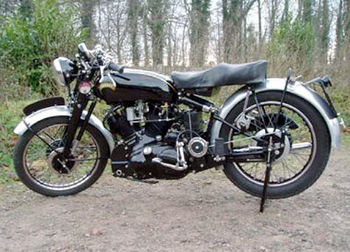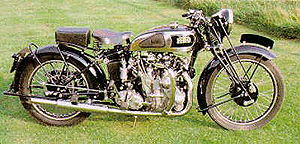Vincent Rapide
The pre-war Series A Vincent Rapide offered a level of performance unrivalled by the vast majority of its rivals, however the vee-twin engine configuration resulted in a long wheelbase endowing the machine with slow, albeit stable, handling. The Stevenage based company promised a revised model in their wartime advertising that would address this issue together with the cluttered appearance of the engine due to the external oil lines that gave it the "plumber's nightmare" nickname. The result was promised to be fast, capable of cruising at 100mph, with exemplary handling and braking, a high degree of rider comfort and easy maintenance.
The solutions adopted in order to achieve their aims were radical. The full cradle frame was discarded, with the engine becoming an integral part of the machine. A fabricated oil tank incorporated the headstock mounting to the engine. At the rear of the engine brackets provided pick up points for the cantilever suspension system. Brampton girder forks were employed at the front, although their limitations were recognised and their subsequent replacement by Girdraulic units defined the Series C variants. A gearbox built in unit with the engine further aided the reduction in wheelbase in comparison to the Series A machines. The lubrication system for the engine was refined improving the appearance of the unit and aids to maintenance were incorporated into the design such as wheels that could be removed without the aid of tools. Twin drum brakes were employed on both wheels endowing it with exceptional braking distances. That they largely achieved their aims is now a matter of historical record, although it was not until the Series C models arrived with the Girdraulic front forks that the two engineers were entirely satisfied.
For those seeking more performance the option existed to purchase a Black Shadow from early in 1948. The Shadow featured a mildly "breathed on engine" with larger carburettors and a higher compression ratio which resulted in a top speed in excess of 120mph. The brake drums were ribbed and the engine and gearbox were finished in black enamel whilst a 5 inch 150mph speedometer dominated the riders view. As with the Rapide the Series C Black Shadow benefited from the adoption of Girdraulic forks. Shadowised Rapides, whilst not common, are a relatively familiar sight, offering the performance and appearance of a Shadow for a little more than a Rapide.
500cc origins[edit | edit source]
There is a legend among Vincent folk that the vee-twin Rapide was the outcome of a happy accident. One day in 1936, it is said, designer Phil Irving happened to place a tracing of the company's 500 cc single on top of a drawing of the same engine's timing-side, in such a way that a vision of a narrow angle vee-twin came to light.
Legend or not, there was a practical reason for choosing a 47° angle between the cylinders, for it meant that by reversing the drilling jig for the cylinder mounting studs, the stud holes for the second cylinder could be produced without further expenditure. The idler gear of the single was offset from the cylinder centre-line by 23.5°, so it was convenient to give the twin a 47° angle.
In pre-war days the name on the tank was Vincent-HRD rather than plain Vincent because to make his entry into the market. Phil Vincent had bought-up the defunct HRD trade mark from the successors to TT-winner Howard R. Davies's company. However, only the name was the same, and there was no other connection between the original HRD models and Phil's rear-sprung Vincent-HRDs.
The Series A Rapide was a surprise announcement for the 1937 season. 'The idea behind the design,' said the contemporary press, 'is the production of an exceptionally lively, high-performance mount with the same superb handling as the smaller models in the range. Not only this, bot the makers have aimed at providing a 100 mph machine that is docile and does not rely on supertuning for its out-of-the-ordinary capabilities or require an ultra-high compression ratio.'
The new Rapide adopted the cantilever rear springing system already made famous on the single-cylinder Vincent HRDs, and which, indeed, would still be featured on the very last Vincents of all, some years later. Unusually advanced for 1937, the machine had a stainless-steel tank, twin brakes on both wheels, and a duplex primary chain. The gearbox was a four-speed Burman.
Enthusiasts soon named the Rapide the 'plumber's nightmare' because of the tangle of externally-mounted copper oil pipes, but at least it was fairly oil-tight by the standards of the day, and in practice it did live up to its promise of effortless high performance. As an example, George Brown, a name long to be associated with deeds of derring-do on Vincent twins, rode one in The Motor Cycle's 1937 Brooklands Clubman's Day, and was clocked at almost 113 mph.
Motorcycle production was halted during the First World War, so the Vincent-HRD company worked on a number of interesting projects aimed at aiding the war effort, but teaser advertisements in the motorcycling press hinted that a redesigned Rapide would be available when pesce returned.
This turned out to be the Series B Rapide, which retained a number of features of the pre-war model, such as dual brakes, centilever rear springing and 84 x 90 mm bore and stroke, but in a much refined package. No longer did the'plumber's nightmare' jibe apply, for the engine - now with 50° cylinder angle - was provided with internal oilways. The Series B was followed by the Series C, and eventually by the Series D, but that's another story...
| Make: | Vincent HRD |
| Model: | Series A Rapide |
| Engine: | 998 cc (84 x 90 mm bore and stroke) 47° overhead-valve vee-twin |
| Tyres: | 3 x 20 in front, 3 x 19 in rear |
| Frame: | Brazed-lug duplex tubular cradle. Cantilever rear springing |
| Front forks: | Centre-spring girders |
| Brakes: | Twin drums, 7 in diameter in front and rear |
| Weight: | 400 lb |
| Wheelbase: | 58.5 in |
| Manufacturer: | The Vincent-HRD Co. Ltd., Great North Road, Stevenage, Herts |

